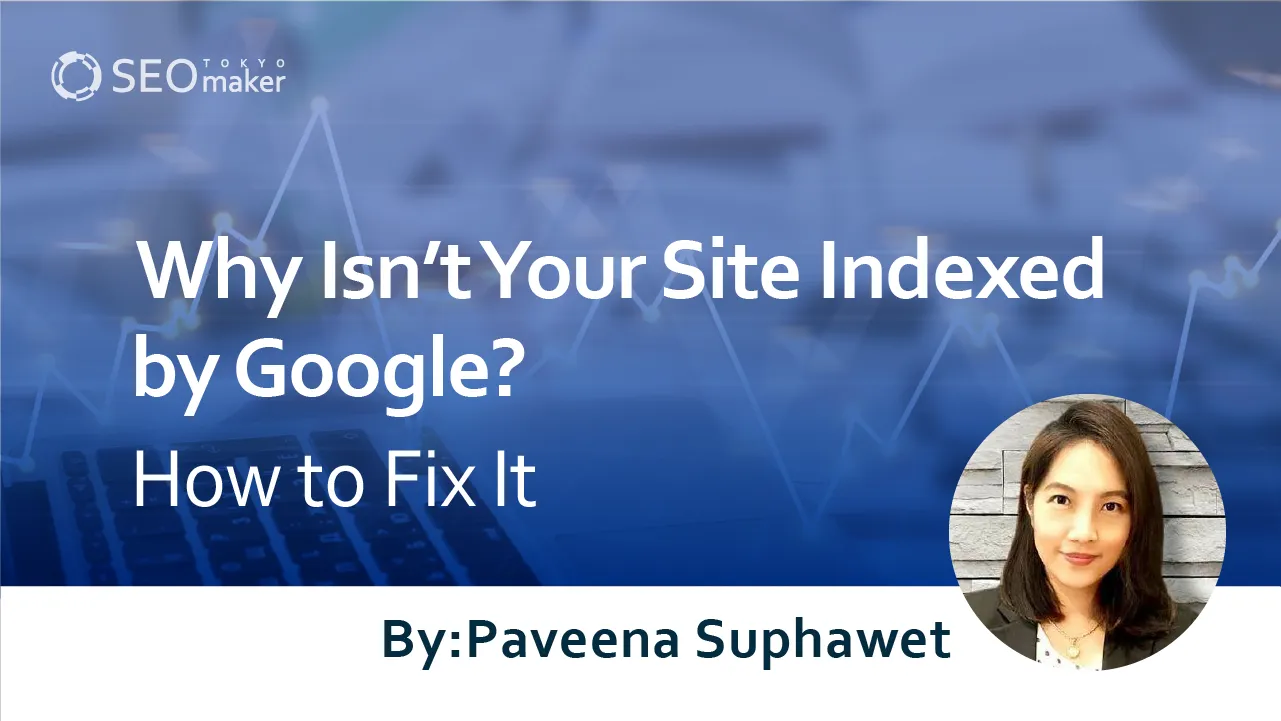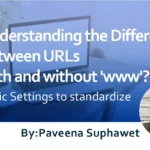Why Isn’t Your Site Indexed by Google? : How to Fix It
contents
- 1 Your Company’s Pages Not Indexed by Google: Reasons and Solutions
- 1.1 Reasons Your Pages Aren’t Indexed by Google
- 1.2 Penalized by Google
- 1.3 Low Backlink Count
- 1.4 Just launched a new website
- 1.5 Blocked by robots.txt File
- 1.6 Blocked by noindex Directive
- 1.7 Mobile-Friendly Check
- 1.8 Page Loading Speed
- 1.9 Meeting Search Intent
- 1.10 Implementing Internal Links
- 1.11 Backlink Strategies
- 1.12 Breadcrumb Navigation
- 1.13 XML Sitemap Installation
- 2 Summary

If your company’s website pages aren’t indexed by Google, there’s likely a reason on the user’s end. In this article, we’ll explore the reasons why your site might not be indexed and provide solutions. Finally, we’ll introduce a checklist of things to review on your company’s site.
If you’re struggling with pages not being indexed by Google, this guide is for you.
Your Company’s Pages Not Indexed by Google: Reasons and Solutions
If your company’s pages aren’t indexed by Google, there’s likely a user-related issue. Here are some potential reasons why your pages aren’t indexed by Google
Reasons Your Pages Aren’t Indexed by Google
- Penalized by Google
- Low backlink count
- Newly launched website
- Blocked by robots.txt file
- Denied by noindex directive
- Google’s technical issues
Let’s delve into each of these reasons and their respective solutions. Here, we’ll assume you’re aiming to get indexed by Google but are facing obstacles.
Penalized by Google
One reason for not being indexed is being penalized by Google. Google has established ” Quality Guidelines ” for website operations, defining violations in website management.
These violations include;
- Buying or selling backlinks (Purchasing backlinks from vendors)
- Copying content from other websites
- Hidden text or links
- Automatically generated content
- Content created solely to redirect to another site
- Low-value affiliate sites and etc.
In addition to violations outlined in Quality Guidelines, Google may manually block indexing for content it deems violating.
Google penalties fall into two categories: manual and automatic. With manual penalties, you’ll receive a message in Google Search Console detailing the cause. In the case of automatic penalties, identifying the cause can be challenging. Therefore, it’s essential to review the ” Quality Guidelines ” to avoid Google penalties.
Low Backlink Count
Low backlinks may affect your site’s indexing status due to lowered priority. Backlinks refer to URLs of your media placed on external websites. Google prioritizes sites with many high-quality backlinks.
Google crawls a vast number of websites, prioritizing based on backlink count. A low count may result in a lower evaluation from Google.
To acquire backlinks, consider
- Delivering emotionally resonant content
- Providing valuable information for readers to share
- Offering specialized content
By delivering valuable content that addresses users’ needs, you encourage other websites to link to yours. To improve the quality of your content so it gets indexed by Google, focus on solving the problems and addressing the unknowns of search users.
Just launched a new website
When launching a new website, it’s common to encounter cases where Google doesn’t index it. Similar to having few backlinks, this might be due to the priority of web crawlers.
If you’ve just launched a new website, there isn’t an immediate solution. Launching a website doesn’t guarantee instant results; managing owned media is no easy feat.
Consistently publishing content and gradually enhancing your website’s reputation are crucial.
Blocked by robots.txt File
Unintentionally blocking crawlers through the robots.txt file could be the reason your site isn’t indexed. The robots.txt file informs search engine crawlers which URLs of the website they’re allowed to access.
This file is primarily used on large-scale websites to control crawlers from indexing certain pages.
Here’s an example of how the robots.txt file is structured
User-agent: Googlebot
Disallow: /nogooglebot/
User-agent: *
Allow: /
Sitemap: https://www.yoursite.com/sitemap.xml
If you have created a robots.txt file like the above, you are instructing crawlers not to visit your website. Therefore, you should delete the robots.txt file via FTP.
Blocked by noindex Directive
Unintentionally setting the noindex directive might be causing you to block Google’s indexing. The noindex directive allows you to block crawler indexing on a per-page basis. This tag can be easily set through the CMS dashboard, leading to unintentional configurations.
The noindex tag is primarily placed within the <head> element using the following tag
<meta name=”robots” content=”noindex”>
To remove noindex, delete the above tag.
Google Glitches
While not very common, it’s possible that your website isn’t indexed due to technical glitches on Google’s end. Even if there are no issues on your end, there might be cases where indexing doesn’t occur due to problems with Google’s systems.
Information about Google’s glitches may be posted on the Google Search Central blog or Twitter . If you want to stay updated on the latest glitch information, consider bookmarking or following these channels.
How to Check if Your Site is Indexed by Google
To check if your website itself is indexed, simply add “site:” before your domain name in the search box. For example, searching “site: www.switchitmaker2.com ” will show if your website is indexed.
If you want to check if individual pages are indexed, you can use the URL inspection tool in Google Search Console. Here’s how to check for indexing status on a per-page basis
- Log in to Google Search Console .
- Select “URL inspection” from the left menu.
- Enter the URL of the page you want to check.
If your website isn’t indexed, you’ll see a message like “URL is not on Google: Indexing error” along with the possible reasons. Take appropriate action based on the provided information.
Checklist for Site Structure and Content Review
To ensure your website gets indexed by Google, here’s a checklist to review your site structure and content
- Ensure there’s no duplicate content.
- Make sure your site is mobile-friendly.
- Check if your page loading speed is satisfactory.
- Ensure your content addresses search intent.
- Implement internal linking.
- Implement backlink strategies.
- Include breadcrumbs navigation.
- Have an XML sitemap.
While this list isn’t exhaustive, it covers the essential items you should check. Make sure to reference it for a thorough review.
Avoiding Duplicate Content
It goes without saying, but make sure your content isn’t duplicated from other websites. If Google identifies duplicate content, your site might face penalties and indexing issues.
Especially when outsourcing content creation to external writers, be sure to check for plagiarism. Using a free plagiarism checker tool like “CopyContentDetector” can ensure all content is original and avoid any issues.
Mobile-Friendly Check
Let’s make sure your website is mobile-friendly. Being mobile-friendly means your website is easy to view on smartphones.
There’s something called responsive design, which makes websites easy to view on both computers and smartphones. Let’s check if responsive design is in place.
Page Loading Speed
The loading speed of your pages is one of the factors Google considers when evaluating websites. If your website is slow to load, it might be perceived as having low-quality content.
You can check your page loading speed using PageSpeed Insights. Simply input your website’s URL, and it’ll give you a score. Aim for a score of 85 or above.
If your page loading speed is slow, here are some specific ways to improve it.
- Compress images and videos.
- Minify CSS.
- (For mobile) Use AMP etc.
Make sure your pages load as quickly as possible.
Meeting Search Intent
Check if your content aligns with the search intent. Google also recommends creating content that meets the needs of search users.
Search intent refers to the underlying thoughts users have when searching with a keyword. Users search on Google or Yahoo! to address concerns or solve problems.
Therefore, be mindful not to create low-quality websites that merely promote affiliate products without addressing the concerns or anxieties of search users.
Implementing Internal Links
Install internal links to improve user engagement and gain recognition from Google. Internal links connect articles within your own site.
By placing articles that address the needs of search users in optimal locations, you’ll encourage users to read more content on your site. The more content users consume on your site, the higher your website will be evaluated.
When creating content, be sure to prioritize the placement of internal links.
Backlink Strategies
In addition to internal links, focus on backlink strategies. As mentioned earlier, acquiring external links is crucial for current SEO strategies.
To acquire backlinks, consider creating content that resonates with your audience and writing high-quality articles.
Let’s check if your company website has breadcrumb navigation installed. Breadcrumb navigation shows users where they are within the site hierarchy. By implementing breadcrumb navigation, you can organize your website for easy viewing and positively impact Google’s crawling.
There are benefits such as “improving user convenience” and “facilitating crawler navigation,” so it’s advisable to set up breadcrumb navigation. In the case of WordPress, you can create breadcrumb navigation using a plugin called ” Breadcrumb NavXT .”
XML Sitemap Installation
An XML sitemap is a file used to communicate the structure of a website to Google’s crawlers.
If you haven’t installed an XML sitemap, it’s recommended to do so to make it easier for crawlers to navigate your site. Additionally, there’s a detailed explanation about sitemaps in the following article, so be sure to check it out:
Reference Article: Does a Sitemap Have SEO Benefits? Learn about the Risks Associated with Sitemaps
Summary
In summary, when a website isn’t indexed by Google, the majority of the time, the issue lies on the user’s end. Therefore, let’s practice the causes and solutions outlined in this article. Furthermore, improving the quality of content is essential for being indexed by Google.










![What is a Description? Explaining the Meaning, Writing Style, and Changing Word Count – [2023 Edition]](https://www.switchitmaker2.com/en/wp-content/uploads/2024/09/what-is-description.webp)










